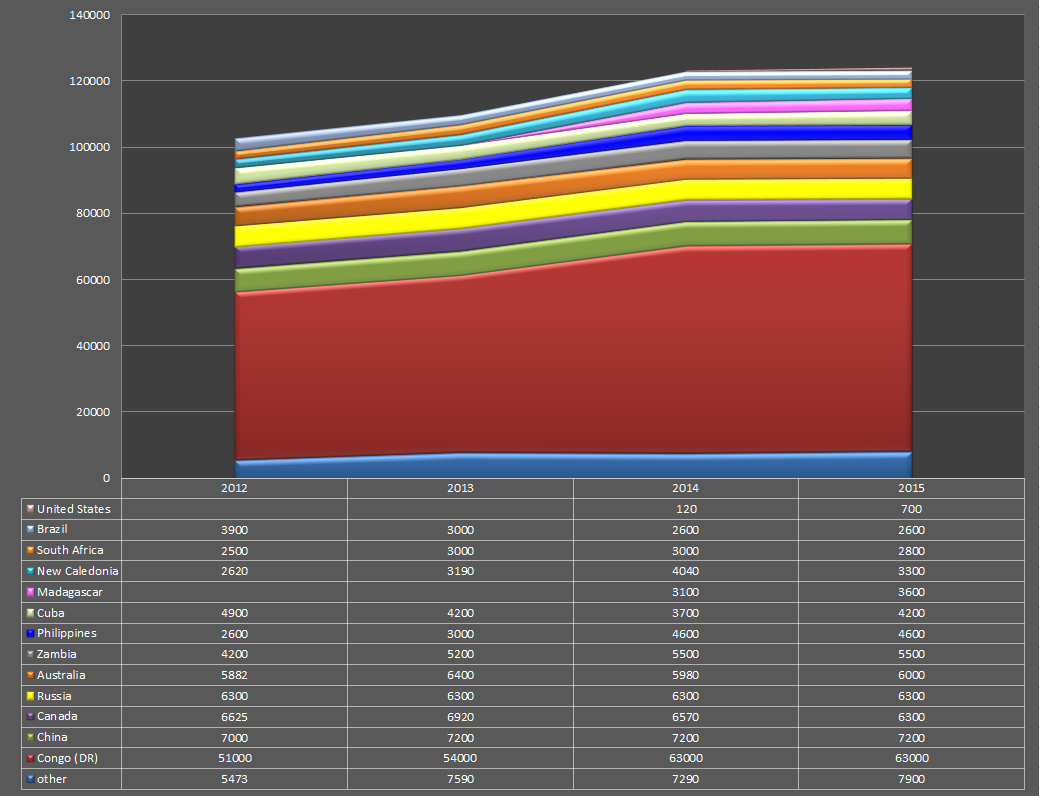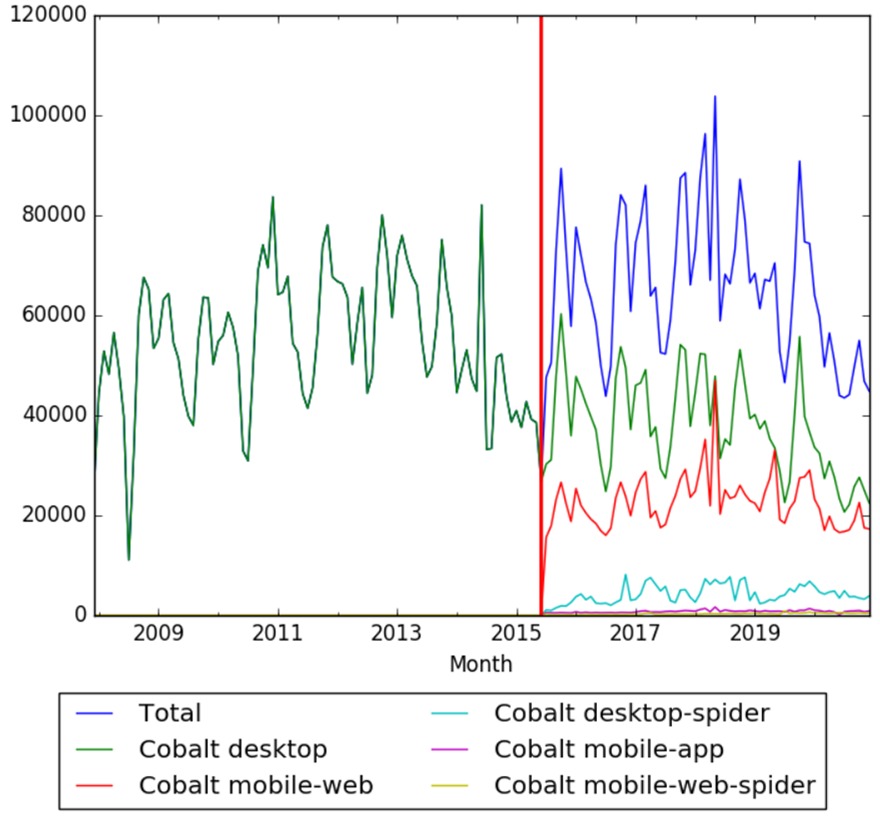Timeline of cobalt
From Timelines
This is a timeline of cobalt, attempting to describe important events related to the discovery, industrial development, and trends in application and production of the metal.
Contents
Big picture
| Time period | Development summary |
|---|---|
| Ancient times | Cobalt has been used to color pottery and glass for at least 2600 years, evidenced by cobalt-containing glazes having been found in Ancient Egyptian tombs. Blue colours made from cobalt-containing minerals are also found in Chinese pottery from Tang (600-900 AD) and Ming dynasties (1350-1650 AD).[1] About the beginning of the Christian era, cobalt is a major coloring agent used by Greek glassworkers.[2] |
| 16th century | The name kobold is first applied to ores thought to contain copper but eventually found to be poisonous arsenic-bearing cobalt ores.[3] |
| 18th century | Swedish chemist Georg Brandt first isolates cobalt in 1735. After its isolation, cobalt metal would remain rare and seldom used until the 20th century.[4] |
| 20th century | In the early 20th century, cobalt-bearing ores are discovered in Africa.[2] Prior to World War I most of the world’s production of cobalt is consumed in the ceramic and glass industries.[5] The cobalt, in the form of cobalt oxide, serves as a colouring agent The metallic uses of cobalt stem from Elwood Haynes’ studies and patents in the early 1900s.[1] A significant development for cobalt comes with the creation of aluminum-nickel-cobalt (AlNiCo) magnets in the 1940s.[4] In the 1960s cobalt compounds are postulated as being promising hard magnet materials.[6] In the 1970s, the industry is further transformed by the development of samarium-cobalt magnets, which provide previously unachievable magnet energy densities.[4] |
| 21st century | Today cobalt is present in many important types of magnet which cover a range of applications.[6] Currently, the Democratic Republic of the Congo holds over 50% of global reserves and is responsible for around 50% of global cobalt production.[1] China, Canada, and Russia are also important producers.[3] |
Visual data
Wikipedia views
Full timeline
| Year | Event type | Details | Country |
|---|---|---|---|
| 3000 BC | Application | Cobalt is detected in Egyptian statuettes and Persian necklace beads.[3] | |
| 1735 | Scientific development | Swedish chemist Georg Brandt first isolates cobalt from copper ore.[4][1][2][7] | Sweden |
| 1742 | Scientific development | Georg Brandt determines that the blue color of kobold ores is due to the presence of cobalt.[3] | Sweden |
| 1780 | Application | Swedish chemist Sven Rinman discovers pigment cobalt green.[8][9][10][11] | |
| 1802 | Application | Louis Jacques Thénard discovers pigment cobalt blue.[9][10] | |
| 1874 | Production | The output of cobalt from European deposits is surpassed by production in New Caledonia.[5] | New Caledonia |
| 1905 | Production | Canada becomes leader in cobalt production.[5] | Canada |
| 1907 | Application | American automotive entrepreneur Elwood Haynes patents a new corrosion resistant alloy, which he refers to as stellite. Stellite alloys contain high cobalt and chromium contents and are completely non-magnetic.[4] | United States |
| 1916 | Production | Total cobalt output stands at 554 tons of which 400 tonnes were produced as oxides for colorings.[1] | |
| 1917 | Application | Cobalt starts being used for its magnetic properties in magnetic steels.[6] | |
| 1920 | Production | Belgian Congo assumes leadership in cobalt production.[5] | Democratic Republic of the Congo |
| 1924 | Scientific development | It is discovered that cobalt-chromium alloy offers the most ideal set of properties for use in prosthetics.[12] | |
| 1934 | Production | The production of cobalt in the Belgian Congo is reported at 1500 metric tons in the year. At its peak, Congo would produce nearly half of the world's cobalt from two refineries at Likasi and Kolwezi, both operated by Générale des Carrières et des Mines.[13] | Democratic Republic of the Congo |
| 1937 | Application | Cobalt-chromium-molybdenum alloy Vitallium is used in prosthetics, offering good strength, corrosion resistance and bio-compatibility.[12] | |
| 1938 | Scientific development | John Livingood and Glenn T. Seaborg discover the radioisotope cobalt-60.[14] | |
| 1950 | Application | The concept of a cobalt bomb as a nuclear weapon is originally described in a radio program by physicist Leó Szilárd.[15] | |
| 1958 | Production | Production of cobalt in the United States reaches a maximum of just over 2000 tons in ore, mostly from the Blackbird mine in Idaho. | United States |
| 1970 | Application | Samarium-cobalt (Sm-Co) magnets start being produced from sintering. These magnets would soon come into prominence in the market place.[6][4] | |
| 1975–1980 | Application | In the late decade, approximately one quarter of cobalt consumption in the United States is for chemical uses, and three quarters for metallurgical uses.[16] | United States |
| c.1980 < | Production | Zambia starts promoting the expansion of its cobalt production in an attempt to offset declines in the country's copper output.[17] | Zambia |
| 1982 | Organization | The Cobalt Development Institute (CDI) is founded. It comprises 60 members from 18 countries.[17] | |
| 1992 | Production | The Ugandan government initiates a project to extract cobalt from stockpiles of cobaltiferous concentrate at the Kilembe copper mine, in south-western Uganda.[17] | Uganda |
| 1998 | Application | The top two applications using cobalt catalysts are the hydroprocessing of petroleum and the production of terephthalic acid (TPA) and dimethyl terephthalate (DMT), which are intermediate compounds in the production of polyester.[16] | |
| 2003 | Extraction | About 44% of world cobalt production comes from nickel ores (i.e., laterites and sulfides).[7] | |
| 2004 | Reserves | According to the United States Geological Survey, the world cobalt resources are approximately 15 million tons.[7] | |
| 2005 | Production | The major companies producing cobalt worldwide are, inorder of decreasing annual production capacity, the 100 Chinese producers (12,700 tons), the US producer OMG (8164 tons), Vale Inco from Canada (6350 tons), Norilsk Nickel in Russia (4990 tons), and Chambashi Metals in Zambia (3630 tons).[7] | |
| 2010 | Financial | As a result of the industrial importance of cobalt, the London Metal Exchange (LME) introduces cobalt futures contracts in.[4] | United Kingdom |
| 2010 | Production | According to United States Geological Survey (USGS) estimates, global mine production of cobalt is reported at 88,000 tons in the year. The largest cobalt ore producing countries during that period are the Democratic Republic of the Congo (45,000 tons), Zambia (11,000) and China (6,200).[4] | |
| 2016 | Application | The Washington Post reports that electric cars typically contain "20 to 30 pounds" worth of cobalt in them.[18] | |
| 2017 | Controversy | Following allegations of child labor in the extraction of cobalt in the Democratic Republic of Congo, Apple Inc. starts treating the metal as a conflict mineral, and requires all cobalt suppliers to agree to outside supply-chain audits and risk assessments.[19] After a Sky News follow-up showing that child labor continue to be utilized,[20] Apple announces stop buying cobalt mined by hand in DRC entirely.[21] | |
| 2018 | Application | As of date, nearly 80% of the cobalt produced is used in batteries for mobile devices.[22] | |
| 2027 | Production | Metals consultancy Roskill estimates cobalt demand at 310,000 tons by that year, of which more than 240,000 tons will come from batteries used in electric vehicles, laptops and mobile phones.[23] | |
| 2030 | Demand | Bloomberg New Energy Finance estimates that by that year global demand could be 47 times more than it was in 2017.[24] |
Meta information on the timeline
How the timeline was built
The initial version of the timeline was written by User:Sebastian.
Funding information for this timeline is available.
Feedback and comments
Feedback for the timeline can be provided at the following places:
- FIXME
What the timeline is still missing
Timeline update strategy
See also
External links
References
- ↑ 1.0 1.1 1.2 1.3 1.4 "History of Cobalt". cobaltinstitute.org. Retrieved 25 July 2018.
- ↑ 2.0 2.1 2.2 Nickel, Cobalt, and Their Alloys (Joseph R. Davis ed.).
- ↑ 3.0 3.1 3.2 3.3 "Cobalt". britannica.com. Retrieved 25 July 2018.
- ↑ 4.0 4.1 4.2 4.3 4.4 4.5 4.6 4.7 "Cobalt Metal - Properties, Production, and Applications". thebalance.com. Retrieved 25 July 2018.
- ↑ 5.0 5.1 5.2 5.3 "Cobalt processing". britannica.com. Retrieved 25 July 2018.
- ↑ 6.0 6.1 6.2 6.3 "Magnetic Alloys". cobaltinstitute.org. Retrieved 25 July 2018.
- ↑ 7.0 7.1 7.2 7.3 Cardarelli, François. Materials Handbook: A Concise Desktop Reference.
- ↑ The Elements.
- ↑ 9.0 9.1 Tamilselvan, Kalpanadevi. Metal Hydrazine Cinnamates. Synthesis and Characterization.
- ↑ 10.0 10.1 Chemical Elements.
- ↑ Gehlen, A. F. (1803). "Ueber die Bereitung einer blauen Farbe aus Kobalt, die eben so schön ist wie Ultramarin. Vom Bürger Thenard". Neues allgemeines Journal der Chemie, Band 2. H. Frölich. (German translation from L. J. Thénard; Journal des Mines; Brumaire 12 1802; p 128–136)
- ↑ 12.0 12.1 "Prosthetic Alloys". cobaltinstitute.org. Retrieved 25 July 2018.
- ↑ Kisangani, Emizet Francois. Historical Dictionary of the Democratic Republic of the Congo.
- ↑ Livingood, J.; Seaborg, Glenn T. (1938). "Long-Lived Radio Cobalt Isotopes". Physical Review. 53 (10): 847–848. Bibcode:1938PhRv...53..847L. doi:10.1103/PhysRev.53.847.
- ↑ Brian Clegg. Armageddon Science: The Science of Mass Destruction. St. Martins Griffin. p. 77. ISBN 978-1-250-01649-2.
- ↑ 16.0 16.1 Flow studies for recycling metal commodities in the United States. Geological Survey (U.S.).
- ↑ 17.0 17.1 17.2 Africa South of the Sahara 2004. Europa Publications.
- ↑ "Newer Tesla batteries contain Cuban cobalt, likely illegal under US sanctions". arstechnica.com. Retrieved 26 July 2018.
- ↑ "Companies respond to questions about their cobalt supply chains".
- ↑ "Meet Dorsen, 8, who mines cobalt to make your smartphone work".
Traders then sell it mostly to exporter Congo Dongfang International, a subsidiary of Zhejiang Huayou Cobalt, which supplies most of the world's largest battery makers.
- ↑ "Apple cracks down further on cobalt supplier in Congo as child labor persists".
- ↑ "How To Minimize Tesla's Cobalt Supply Chain Risk". seekingalpha.com. Retrieved 26 July 2018.
- ↑ "Japan takes steps to ensure stable cobalt supply for automakers". reuters.com. Retrieved 26 July 2018.
- ↑ Thomas Wilson (October 26, 2017). "We'll All Be Relying on Congo to Power Our Electric Cars". Archived from the original on March 1, 2018.

